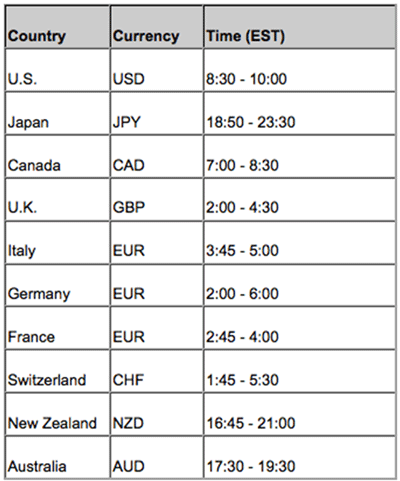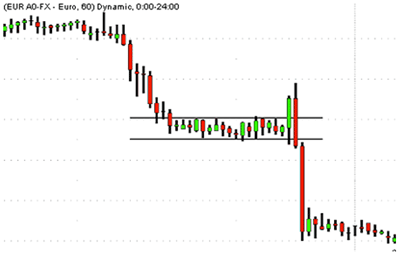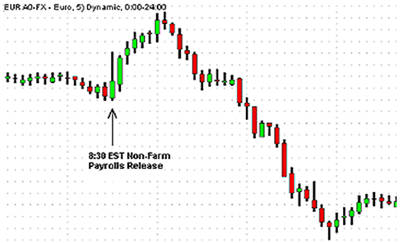The currency market is particularly prone to short-term movements brought on by the release of economic data. Here are key considerations for trading the news more safely and successfully.
By Kathy Lien
One of the great advantages of trading currencies is that the forex market is open 24 hours a day (from 5 pm EST on Sunday until 4 pm EST Friday). Economic data tends to be one of the most important catalysts for short-term movements in any market, but this is particularly true in the currency market, which responds not only to US economic news, but also to news from around the world.
With at least eight major currencies available for trading at most currency brokers and more than 17 derivatives of them, there is always some piece of economic data slated for release that traders can use to inform the positions they take. Generally, no less than seven pieces of data are released daily from the eight major currencies or countries that are most closely followed. So for those who choose to trade news, there are plenty of opportunities. Here, we look at which economic news releases are released when, which are most relevant to forex (FX) traders, and how traders can act on this market-moving data.
Which Currencies Should Be Your Focus?
The following are the eight major currencies:
1. US dollar (USD)
2. Euro (EUR)
3. British pound (GBP)
4. Japanese yen (JPY)
5. Swiss franc (CHF)
6. Canadian dollar (CAD)
7. Australian dollar (AUD)
8. New Zealand dollar (NZD)
This is just a sample of some of the more liquid derivatives based on the currencies above.
(Build charts of each of these currencies on MoneyShow.com here.)
1. EUR/USD
2. USD/JPY
3. AUD/USD
4. GBP/JPY
5. EUR/CHF
6. CHF/JPY
As you can see from these lists, the currencies that we can easily trade span the entire globe. This means that you can handpick the currencies and economic releases to which you pay particular attention. But, as a general rule, since the US dollar is on the "other side" of 90% of all currency trades, US economic releases tend to have the most pronounced impact on the market.
NEXT: Trading the News Is Harder Than It Seems
|pagebreak|Trading the news is harder than it may sound. Not only is the reported consensus figure important, but so are the whisper number and the revisions. Also, some releases are more important than others; this can be measured in terms of both the significance of the country releasing the data and the importance of the release in relation to the other pieces of data being released at the same time.
When Are News Releases Issued?
The graphic below lists the approximate times (EST) at which the most important economic releases for each of the following countries are published. These are also the times at which you should be paying extra attention to the markets if you plan on trading news releases.
What Are the Key Releases?
When trading the news, you first have to know which releases are actually expected that week. Second, it is key for you to know which data is important. Generally speaking, these are the most important economic releases for any country:
1. Interest rate decisions
2. Retail sales
3. Inflation (consumer price or producer price)
4. Unemployment
5. Industrial production
6. Business sentiment surveys
7. Consumer confidence surveys
8. Trade balance
9. Manufacturing sector surveys
Depending on the current state of the economy, the relative importance of these releases may change. For example, unemployment may be more important this month than trade or interest rate decisions. Therefore, it is important to keep on top of what the market is focusing on at the moment.
How Long Does the Effect Last?
According to a study by Martin D.D. Evans and Richard K. Lyons published in the Journal of International Money and Finance (2004), the market could still be absorbing or reacting to news releases hours, if not days, after they are released. The study found that the effect on returns generally occurs in the first or second day, but the impact does seem to linger until the fourth day. The impact on order flow, on the other hand, is still very pronounced on the third day and is still observable on the fourth day.
NEXT: How to Actually Execute News-Based Trades
|pagebreak|How to Actually Trade the News
The most common way to trade news is to look for a period of consolidation ahead of a big number and to simply trade the breakout on the back of the number. This can be done on both a short-term intraday basis and a daily basis. Let's look at the graphic below as an example. After a weak number in September, the market was holding its breath ahead of the October number, which was to be released to the public in November. In the 17 hours before the release, the EUR/USD was confined within a tight, 30-pip trading range. For news traders, this would have provided a great opportunity to put on a breakout trade, especially since the likelihood of a sharp move at this time was extremely high.
This chart illustrates the indecision of the market leading up to the October non-farm payroll numbers, which were released in early November. Note the increase in volatility that occurred once the worse-than-expected news was released.
We mentioned earlier that trading news is harder than you might think. Why? The primary reason is volatility. You can be making the right move but end up being stopped out, or the market may simply not have the momentum to sustain the move.
Let's look at the chart below as an example. This chart shows activity after the same release as the one shown in Figure 2, but on a different time frame to show how difficult trading news releases can be. On November 4, 2005, the market had expected 120,000 jobs to be added to the US economy, but instead only 56,000 jobs were added. This sharp disappointment led to an approximately 60-pip selloff in the dollar against the euro in the first 25 minutes after the release. However, the dollar's upside momentum was so strong that the gains were quickly reversed, and an hour later, the EUR/USD had broken its previous low and actually hit a one-and-a-half-year low against the dollar. Opportunities were plentiful for breakout traders, but bullish momentum in the dollar was so strong that such a bad payrolls number failed to put a sustainable dent in the currency's rally. One thing you should keep in mind is that, on the back of a good number, a strong move should also see a strong extension.
This intraday chart shows that, while the worse-than-expected non-farm payroll numbers sent the EUR/USD rate upward for a short period of time, the strong momentum of the US dollar was able to take control and push the dollar higher. Keep in mind that when the EUR/USD rate falls, the US dollar is going upward, and vice versa.
As we've seen, the currency market is particularly prone to short-term movements brought on by the release of economic news from both the US and the rest of the world. If you want to trade news successfully in the FX market, key considerations to keep in mind include knowing which releases are expected when, which ones are most important given current economic conditions, and of course, how to trade based on this market-moving data. A variety of exotic options are available for traders who want to capture a breakout in volatility without having to face the risk of a reversal. Do your research and stay on top of economic news and you could reap the rewards.
By Kathy Lien of KathyLien.com
Kathy Lien will be speaking at the upcoming Futures and Forex Expo in Las Vegas























